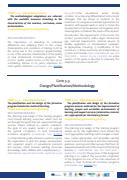ITEM 3.2.4. Educational centerP4,5,6,8,10].The educational center should The methodological adaptations are coherent consider: a) employing differentiated instructional with the available resources attending to the strategies that are aimed at students in the characteristics of the teachers, curriculum, scene classroom; b) using recommended approaches for students with special needs in order to foster theand normative. development of self-awareness, self-regulation andCompletel/Enough/Something/Nothing metacognition; c) balance the needs of the student, the educator, the requirements of the course, the context (environment) within larger frameworksRECOMMENDATIONS: The importance of attending to individual (eg, curricular requirements, national values); d) differences and adapting them to the unique flexible application of individualized measures, characteristics and conditions of training, both at as appropriate, including: 1) modification of the the center and in the company’s apprenticeship, curriculum; 2) foster autonomy and independence; is one of the essential characteristics of the quality 3) tutor and tutorials. [two. International. See: ISO of Dual Professional Formative programs. The 21001:2018 – Section 8.5.1.6.2 a)c)d)]. An entire EQAVET quality system insists on this fact as an section of the guide is devoted to assessing the outstanding feature in its policy objectives for adaptation process in Dual VET. most quality indicators [1.European. See: EQAVET Core 3.3. Design/Planification/Methodology ITEM 3.3.1. Educational center The planification and the design of the formative program include the results of learning. Completel/Enough/Something/Nothing RECOMMENDATIONS: The planning and design of the training program must include learning outcomes, which must be set through the goals that are supervised through success criteria defined by specific indicators. The goal of any quality system is to support the optimal completion of Dual Professional Formative programs. [1.European. See: EQAVET P4] International quality assurance systems require the organization to plan the design, development and expected results of educational products and services, which includes learning outcomes (knowledge, skills, abilities and competencies) [2 . International. See: ISO 21001:2018 – Section 8.1.2.a].ITEM 3.3.2. Educational center The planification and design of the formative program ensures methods for the improvement of learning, proper and accessible environments of learning and support services (orientation, tutorial, etc.) appropriate for the itinerary format. Completel/Enough/Something/Nothing RECOMMENDATIONS: The planning and design of the training program carried out by the organization must include the most appropriate teaching methodologies in each case, create appropriate and accessible learning environments for all students and have mentoring, guidance, tutoring, and other services that favor an adequate development of the student in the training itinerary [1. International. See: ISO 21001:2018 – Section 8.1.2.b)e)f)]. The purpose of this design and planning is to support the successful completion of the programs as one of the main objectives of quality in Dual Professional Formative programs [2.European. See: EQAVET P4]
